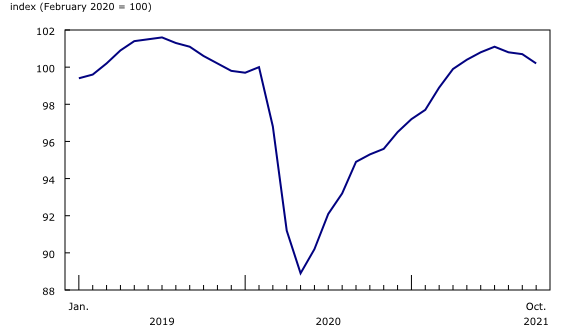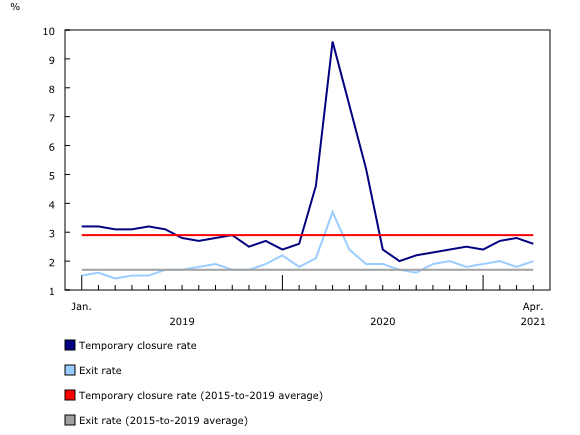OTTAWA
,
January 25, 2022
(press release)
–
Business openings decreased from September to October 2021 (-4.7%, -1,957) after several months of increases. However, the number of business closures also decreased from September to October (-5.7%, -2,367), and as a result, the number of active businesses was relatively unchanged (-0.4%, -3,836). October marked the sixth consecutive month in which the number of active businesses was above February 2020 levels. The decrease in the number of openings was driven by a lower number of business reopenings (-6.3%, -1,624), rather than a lower number of entrants (-2.1%, -333). The decrease in the number of reopenings was largely driven by Ontario (-8.1%, -906), followed by Quebec (-3.3%, -147) and Alberta (-3.7%, -133). After high reopening rates for much of the COVID-19 pandemic, reopening rates in the fall of 2021 were similar to pre-pandemic averages. Though the number of reopenings was lower from September to October, most regions saw a decrease in the number of closures, which allowed the number of active businesses to remain relatively stable for most regions. The number of active businesses only declined in Ontario (-0.5%, -1,851) and Alberta (-0.4%, -502). Across sectors, the largest percentage decreases in the number of active businesses were in the mining, quarrying, and oil and gas extraction sector (-0.8%, -45) and in the transportation and warehousing sector (-0.3%, -137). For the fourth consecutive month, the number of active businesses increased in both arts, entertainment, and recreation (+0.9%, +126) and in accommodation and food services (+0.5%, +305). These increases brought the number of active businesses in these sectors to 4.5% below and 3.5% below pre-pandemic levels, respectively. Exit rate of businesses remains higher than average since October 2020 There is considerable variation across sectors when comparing April 2021 exit rates to their historical averages. The largest difference was in the arts, entertainment, and recreation sector, which had an exit rate of 2.6% in April 2021 compared with its historical average of 1.5%. Other sectors with a large difference between the April 2021 rate and the historical rate were transportation and warehousing (2.2% vs. 1.6%), real estate and rental and leasing (2.6% vs. 2.0%) and professional, scientific and technical services (2.2% vs. 1.7%). For more information on this new series, see "Defining and measuring business exits using monthly data series on business openings and closures," published today. Chart 1: Change in the number of active businesses in the business sector, January 2019 to October 2021, seasonally adjusted series Chart 2: Monthly reopenings and entrants as a percentage of active businesses, business sector, Canada, January 2019 to October 2021, seasonally adjusted series Chart 3: Percentage change in active businesses from September to October 2021, by industry, seasonally adjusted series Chart 4: Monthly temporary closures and exits as a percentage of active businesses, business sector, Canada, January 2019 to April 2021, seasonally adjusted series Chart 5: Monthly exits as a percentage of active businesses, by industry, seasonally adjusted series Note to readers Openings are defined as businesses with employment in the current month and no employment in the previous month, while closures are defined as businesses that had employment in the previous month, but no employment in the current month. Continuing businesses are those that have employees in both months, and the active population in any given month is the number of opening and continuing businesses in that month. Reopening businesses are defined as opening businesses that were also active in a previous month (that is, they closed in a given month and had positive employment in a subsequent month). In contrast, entrants are opening businesses that were not active in a previous month. The definition of exits is based on the Longitudinal Employment Analysis Program (LEAP) annual exits. Because the LEAP definition can require up to 24 months of data to be counted as an exit, projections of exits using predicted growth rates are implemented using a regression model of exits on closures of more than six months. As a result, there are no published exits in the last six months. A temporary business closure is the difference between closures and exits. A business is defined as an enterprise operating in a particular geography and industry. The vast majority of businesses operate in one industry and one location or geography. For these businesses, in the monthly estimates of openings and closures, they will be counted once at the national/provincial level. For example, a retailer in Windsor, Ontario, will be counted as an active business in the Ontario estimates and once in the national estimates. Some businesses can have multiple operations, and these can be in different industries and geographies. For such businesses, in the monthly estimates of openings and closures, they can be counted more than once because they are active in multiple industries or geographies. For example, if a retailer has operations in both Alberta and Ontario, it will be counted as an active business in both provinces, but only once at the national level because it represents only one active firm. Similarly, a firm with retail and wholesale operations will be counted in both industries when individual industries are examined. However, when the business sector is examined, the firm counts only once because at that level it represents one firm active in the business sector. Contact information
The series on temporary business closures and exits (or "permanent closures") has been updated to April 2021. In April 2021, the temporary closure rate was lower than its historical, 2015-to-2019 average (2.6% vs 2.9%), while the exit rate was somewhat higher than its historical average (2.0% vs 1.7%). Both rates had peaked in April 2020, at 9.6% for temporary closures and 3.7% for exits. While both the temporary closure rate and the exit rate fell over the summer of 2020, the exit rate rose in the fall and has been higher than its historical average since October 2020.




Every new month of data leads to a revision of the previously released data due to such factors as the seasonal adjustment process and a new version of the Generic Survey Universe File (or vintage of the Business Register). As such, the estimates may vary compared with a previous release.
For more information, or to enquire about the concepts, methods or data quality of this release, contact us (toll-free 1-800-263-1136; 514-283-8300; infostats@statcan.gc.ca) or Media Relations (statcan.mediahotline-ligneinfomedias.statcan@statcan.gc.ca).
* All content is copyrighted by Industry Intelligence, or the original respective author or source. You may not recirculate, redistrubte or publish the analysis and presentation included in the service without Industry Intelligence's prior written consent. Please review our terms of use.




